Species Forest
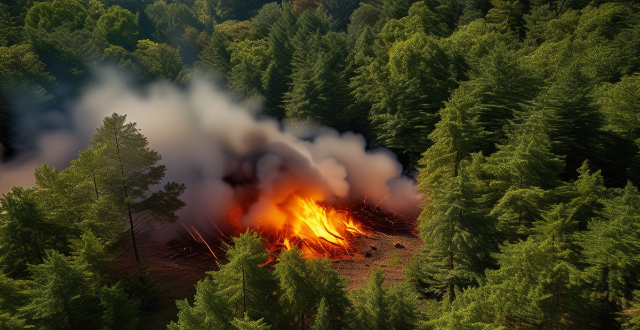
How does climate change affect forest ecosystems ?
Climate change affects forest ecosystems in numerous ways, including changes in temperature and precipitation, shifts in tree species distribution, alterations in fire regimes, increased pest and disease outbreaks, and reduced carbon sequestration. These impacts can lead to heat stress for trees, altered seasonal events, changes in tree growth rates, increased wildfire risk, and even tree mortality during extreme droughts. Invasive species may also outcompete native trees, further altering the structure and function of forest ecosystems. Addressing these challenges will require a multifaceted approach that includes reducing greenhouse gas emissions, protecting and restoring forests, and adapting to changing conditions.

How does climate change influence forest fires and their severity ?
Climate change has a significant impact on forest fires and their severity. The following are some ways in which climate change influences forest fires: - **Increased Temperatures**: Hotter summers and longer fire seasons make it easier for fires to start and spread. - **Droughts and Low Humidity**: Dry conditions make vegetation more flammable and reduce the moisture content in trees and plants. - **Changes in Precipitation Patterns**: Changes in rainfall patterns can create periods of extreme dryness or wetness, both of which can contribute to wildfires. - **Wind Patterns**: Stronger winds can fan flames, causing fires to spread more rapidly and burn more intensely. - **Changes in Vegetation**: Invasive species and tree mortality can increase the risk of fires. Overall, climate change exacerbates many of the factors that contribute to the occurrence and severity of forest fires. By understanding these relationships, we can better prepare for and mitigate the impacts of these devastating events.

What are the impacts of climate change on tree species diversity in forests ?
Climate change significantly impacts tree species diversity in forests through altered growth and reproduction patterns, range shifts, disturbance regimes, direct physiological effects, and changes in ecosystem services. These impacts not only affect the health and structure of forests but also have broader ecological and societal implications.
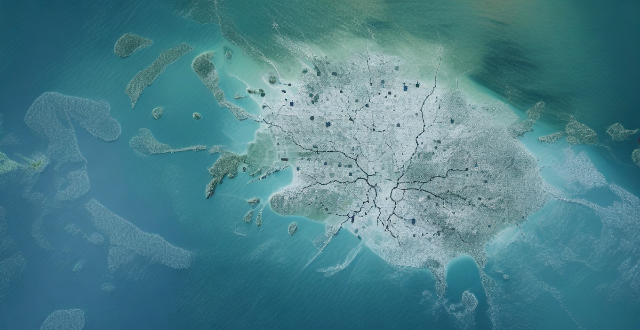
How is global warming impacting biodiversity and endangered species ?
Global warming is impacting biodiversity and endangered species through habitat loss, changes in weather patterns, and increased disease outbreaks. Habitat loss occurs as species are forced to migrate due to rising temperatures, leading to competition for resources and loss of habitats. Changes in weather patterns cause extreme events like droughts, floods, and storms, disrupting ecosystems and potentially leading to species extinction. Additionally, global warming contributes to the spread of diseases among wildlife populations, posing a threat to endangered species. It is crucial to take action to mitigate the effects of global warming and protect vulnerable populations.
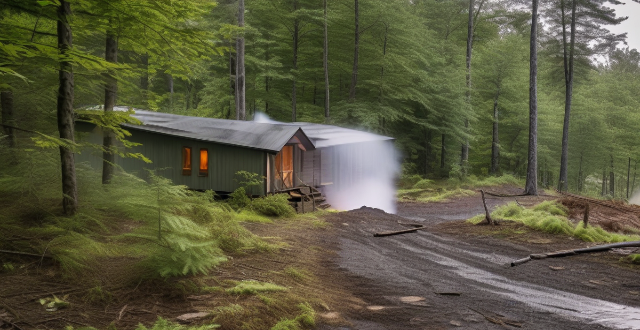
What role do deforestation and forest fires play in global warming ?
Deforestation and forest fires significantly contribute to global warming by increasing greenhouse gas concentrations, altering Earth's reflectivity, and disrupting natural carbon cycles and ecosystem services.
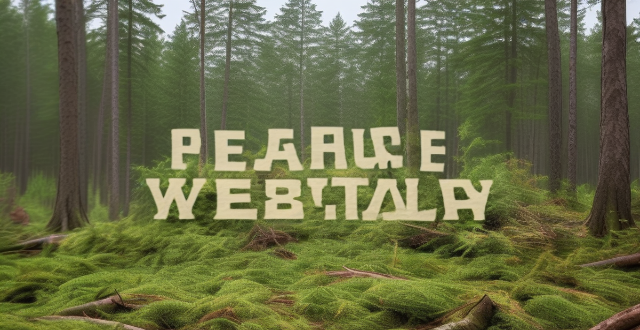
What is the relationship between forest health and the global carbon cycle ?
The text discusses the relationship between forest health and the global carbon cycle. It highlights the importance of forests in absorbing carbon dioxide from the atmosphere and storing it in their biomass, which helps to mitigate the effects of climate change. Deforestation, or the clearing of forests for agricultural or urban development purposes, has a significant impact on the global carbon cycle by releasing carbon stored in trees back into the atmosphere as CO2. Healthy forests are more effective at sequestering carbon than degraded or damaged forests. Several strategies can be implemented to maintain the health of forests, including protecting existing forests, restoring degraded forests, promoting sustainable forestry practices, reducing emissions from deforestation and forest degradation, and increasing public awareness.
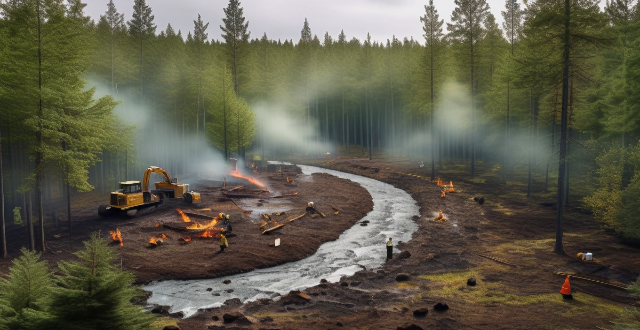
What are the most effective ways to prevent forest fires ?
Preventing forest fires is essential to protect ecosystems, wildlife, and human settlements. Effective strategies include proper land management like clearing dead vegetation, creating fire breaks, and controlled burning; public awareness campaigns through education programs, banning campfires, and posting fire warning signs; using advanced technology such as satellite monitoring, predictive modeling, and drone surveillance; involving the community with volunteer firefighters, reporting systems, and emergency plans; implementing regulatory measures including banning smoking in forests, enforcing building codes, and penalties for negligence; mitigating climate change by reducing emissions and adapting to new norms; and maintaining infrastructure like water sources, access roads, and communication networks. These measures can greatly reduce the risk of wildfires and safeguard both nature and people from their devastating effects.
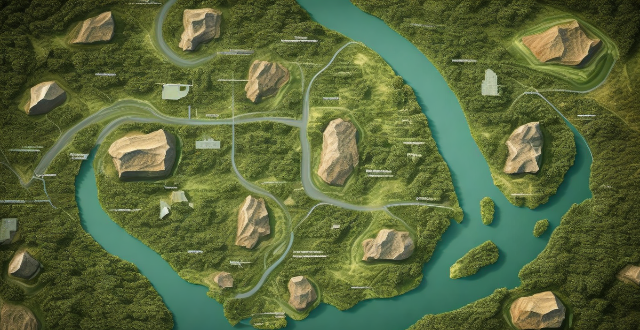
Can climate change cause extinction of certain species ?
Climate change has the potential to cause the extinction of certain species through a variety of mechanisms including rising temperatures, changes in precipitation patterns, loss of habitat, and disruption of food webs. It is essential that we take action to mitigate the effects of climate change and protect vulnerable species before it's too late.
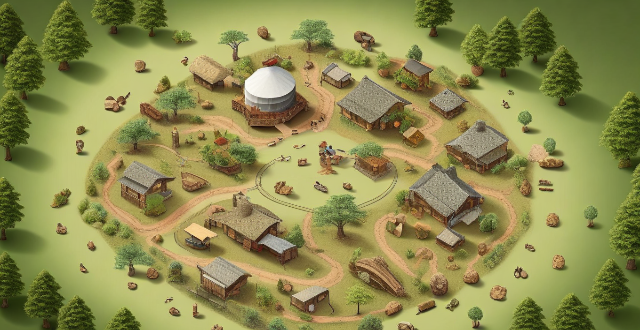
How do invasive species affect biodiversity ?
Invasive species can have a significant impact on native biodiversity, both positively and negatively. They can outcompete and replace native species, leading to changes in community structure and ecosystem function. Invasive species can also cause damage to infrastructure and human health through the spread of disease or destruction of habitats. Management strategies for invasive species include prevention measures such as quarantines and biosecurity protocols, as well as control measures such as eradication programs and habitat restoration. It is important to consider the costs and benefits of each strategy when developing a management plan.

How do deforestation and forest degradation contribute to global warming ?
Deforestation and forest degradation significantly contribute to global warming by reducing carbon sequestration, increasing greenhouse gas emissions, altering the albedo effect, causing biodiversity loss, impacting the water cycle, triggering feedback loops, and posing mitigation and adaptation challenges. These processes also have economic and social impacts, such as displacement of indigenous peoples. Efforts to reduce deforestation and promote sustainable forest management are crucial in combating global warming.

What strategies can be implemented to protect forests from the effects of climate change ?
The article discusses the importance of forests in regulating the Earth's climate and outlines several strategies to protect them from climate change, including afforestation and reforestation, sustainable forest management, fire prevention and control, promoting biodiversity, and education and awareness programs.
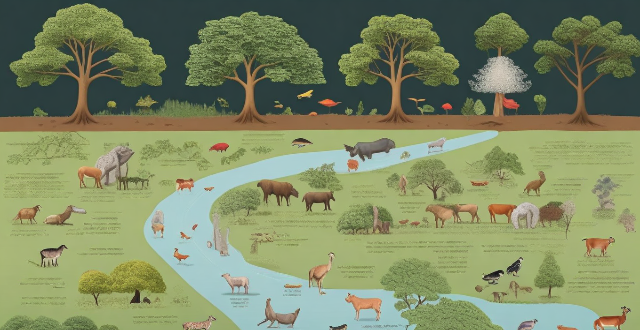
What are the potential consequences of climate change for forest-dependent communities ?
The article discusses the potential consequences of climate change for forest-dependent communities, including loss of habitat and alteration of ecosystems leading to reduced access to resources, changes in precipitation patterns affecting water availability, and impacts on agriculture and food security due to changes in crop yields and increased pests and diseases. Addressing these challenges requires a comprehensive approach that involves both adaptation strategies and efforts to mitigate the effects of climate change.

How can sustainable forest management help in combating climate change ?
Sustainable forest management (SFM) is a key strategy in combating climate change. It balances ecological, economic, and social needs by managing resources without degrading the ecosystem. SFM can help mitigate climate change by enhancing carbon sequestration, promoting ecosystem health, supporting resilient communities, encouraging innovation, and strengthening policy frameworks. By maintaining biomass, reducing emissions from deforestation, conserving biodiversity, storing soil carbon, adapting to climate change impacts, creating economic benefits, fostering research, sharing technology, implementing regulations and incentives, and cooperating internationally, SFM offers a multifaceted approach to promote a greener future.
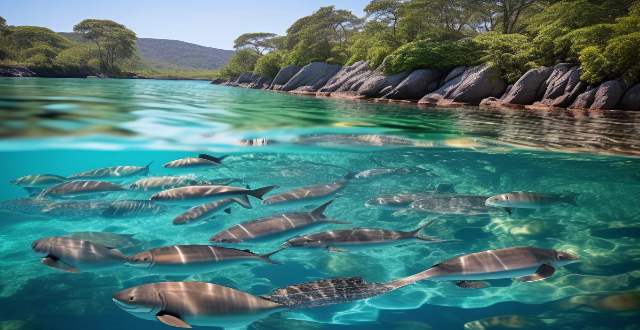
How might climate change influence the distribution and abundance of aquatic species ?
Climate change significantly impacts the distribution and abundance of aquatic species by altering water temperature, pH levels, salinity, and oxygen availability. These changes affect habitats and life cycles of aquatic organisms, causing direct and indirect effects on their survival, growth, reproduction, and community interactions. Some species show resilience through genetic adaptation or phenotypic plasticity. Proactive conservation efforts are crucial for maintaining biodiversity and ecosystem health amid climate shifts.

What are the impacts of global warming on ecosystems and species diversity ?
Global warming, primarily caused by human activities, significantly impacts ecosystems and species diversity. These effects include habitat loss, altered species interactions, the spread of invasive species, disease proliferation, ocean acidification, melting permafrost, changes in fire regimes, water stress, sea level rise, coral bleaching, increased extinction risk, shifting ranges, population declines, adaptation challenges, loss of genetic diversity, behavioral changes, phenological shifts, reproductive challenges, physiological stress, and disrupted mutualisms. Addressing these issues requires immediate action to reduce greenhouse gas emissions and adapt to the changing climate.

How do invasive species interact with climate change to threaten native biodiversity ?
Invasive species and climate change pose significant threats to native biodiversity by exacerbating range expansion, altering competition, increasing predation pressure, degrading habitats, facilitating disease transmission, disrupting mutualisms, having synergistic effects, depleting resources, displacing keystone species, and reducing ecosystem resilience. Integrated management strategies are crucial for mitigating these threats and include habitat restoration, invasive species control, protection of keystone species, and conservation of diverse genetic pools within native species to enhance their adaptability.

How should we prioritize the protection of endangered species and ecosystems ?
The protection of endangered species and ecosystems is a critical issue that requires immediate attention. Here are some strategies we can employ to prioritize their protection: 1. Conduct comprehensive surveys and studies to identify and understand the current state of endangered species and ecosystems. 2. Develop effective legislation and policies, such as establishing protected areas, regulating hunting and fishing, and promoting sustainable development. 3. Raise public awareness and involvement through education programs, community involvement, and media campaigns. 4. Collaborate internationally by signing international agreements, sharing knowledge and resources, and coordinating conservation efforts. By taking these steps, we can work towards ensuring the survival of our planet's diverse flora and fauna for future generations.

What role do trees play in natural carbon sequestration ?
The text discusses the role of trees in natural carbon sequestration, a process that involves the removal and storage of carbon dioxide from the atmosphere. Trees absorb CO2 through photosynthesis and store it in their biomass, contributing to soil organic matter and acting as carbon sinks. Responsible forest management practices and preservation of existing forests are essential for maximizing the potential of these ecosystems for carbon sequestration and mitigating climate change.

What are some successful examples of biodiversity restoration projects ?
This article provides examples of successful biodiversity restoration projects, including the Great Green Wall Initiative in Africa, the Mau Forest Restoration Project in Kenya, the Wolong Giant Panda Reserve Expansion in China, the Coral Reef Restoration Program in the Philippines, and the Amazon Rainforest Conservation Project. These projects aim to restore degraded ecosystems through various techniques such as reforestation, reintroduction of native species, and habitat restoration, with benefits including improved livelihoods for local communities and preservation of biodiversity hotspots.
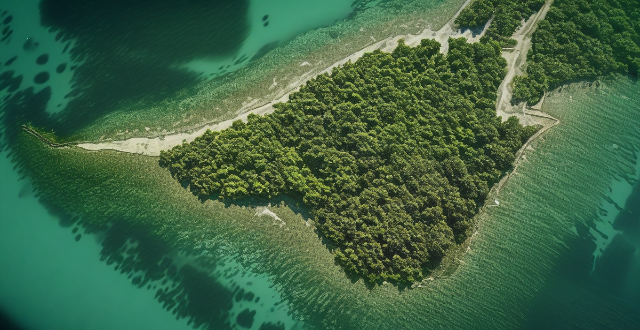
What is the relationship between climate change and loss of habitat for endangered species ?
Climate change is causing significant changes in ecosystems around the world, leading to the loss of habitat for endangered species. Rising temperatures, changing precipitation patterns, sea level rise, and extreme weather events are all factors that contribute to this loss. Endangered species are particularly vulnerable to these changes due to their small populations and limited ranges. Examples of endangered species affected by climate change include polar bears, giant pandas, leatherback turtles, and amphibians. It is essential that we take action to protect these species and their habitats, including reducing greenhouse gas emissions, conserving natural habitats, and developing adaptation strategies.
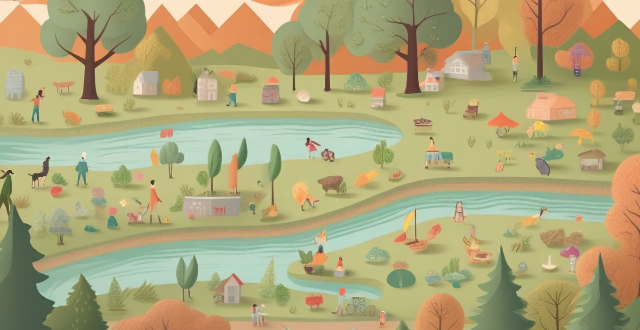
How does climate change affect migration patterns ?
Climate change has significant impacts on migration patterns, affecting routes, timing, and even causing species displacement. Traditional migration pathways become unviable due to rising temperatures and shifting habitats. Altered seasonality disrupts the synchrony between migration events and ecological processes like plant blooming or insect emergence. In extreme cases, species may be forced out of their native ranges entirely. Mitigating strategies include habitat protection, climate change mitigation efforts, adaptation strategies, research and monitoring, and public awareness campaigns.

What role does deforestation play in climate change ?
The Role of Deforestation in Climate Change Deforestation contributes to climate change by reducing the Earth's capacity to absorb CO2 and releasing stored carbon back into the atmosphere. This process exacerbates the greenhouse effect, leading to global warming. Key points include: - Loss of Carbon Sinks: Trees act as natural carbon sinks, capturing and storing CO2. When forests are destroyed, these carbon sinks are lost. - Release of Stored Carbon: Deforestation releases the carbon stored in trees back into the atmosphere, increasing atmospheric CO2 levels. - Biodiversity Loss: Forests are home to a vast array of species. Deforestation leads to habitat destruction and loss of biodiversity. - Soil Erosion and Degradation: Trees help maintain soil quality. Without trees, soil can become degraded, reducing its ability to store carbon. - Albedo Effect: Forests have a darker surface than bare ground, meaning they absorb more sunlight and heat. When forests are replaced with lighter-colored surfaces like grasslands or croplands, the albedo (reflectivity) of the land increases. - Feedback Loops: Deforestation can create feedback loops that exacerbate climate change. For example, as temperatures rise due to increased CO2 levels, it becomes harder for some forests to survive, leading to further deforestation and more CO2 emissions. To combat the role of deforestation in climate change, strategies such as reforestation and afforestation, sustainable forestry practices, protection of intact forests, promotion of agroforestry, and public awareness and education can be employed.

What are the consequences of climate change for wildlife and ecosystems ?
Climate change has significant consequences for wildlife and ecosystems, including habitat loss, changes in species distribution, impacts on biodiversity, altered ecological processes, invasive species spread, pest outbreaks, and human health risks. It is crucial to take action to mitigate these impacts by reducing greenhouse gas emissions and implementing conservation measures.

What is the current status of carbon sequestration projects around the world ?
Carbon sequestration projects are aimed at reducing greenhouse gas emissions by capturing and storing carbon dioxide. These projects include geological storage, ocean storage, and terrestrial storage methods. Geological storage involves injecting CO2 into underground formations, while ocean storage involves injecting it into the deep ocean. Terrestrial storage uses vegetation and soil to sequester carbon through reforestation and improved forest management. These projects have been implemented in various countries worldwide, with notable examples including the Petra Nova project in the United States, the Sleipner project in Norway, and the Amazon Forest Conservation Program in Brazil.

How does deforestation affect global emission levels and what can be done about it ?
Deforestation significantly contributes to global emission levels, primarily through the release of carbon dioxide (CO2) and other greenhouse gases. When trees are cut down or burned, the carbon they have absorbed from the atmosphere during their lifetime is released back into the air. This process exacerbates climate change by increasing the concentration of atmospheric CO2 and other greenhouse gases, which trap heat in the Earth's atmosphere. To mitigate the effects of deforestation on global emissions, various strategies can be implemented, including reforestation, sustainable forest management, reducing demand for forest products, promoting eco-friendly alternatives, strengthening laws and policies, and raising public awareness about the importance of forests in mitigating climate change. By taking these steps, it is possible to reduce the contribution of deforestation to global emissions and work towards a healthier planet.